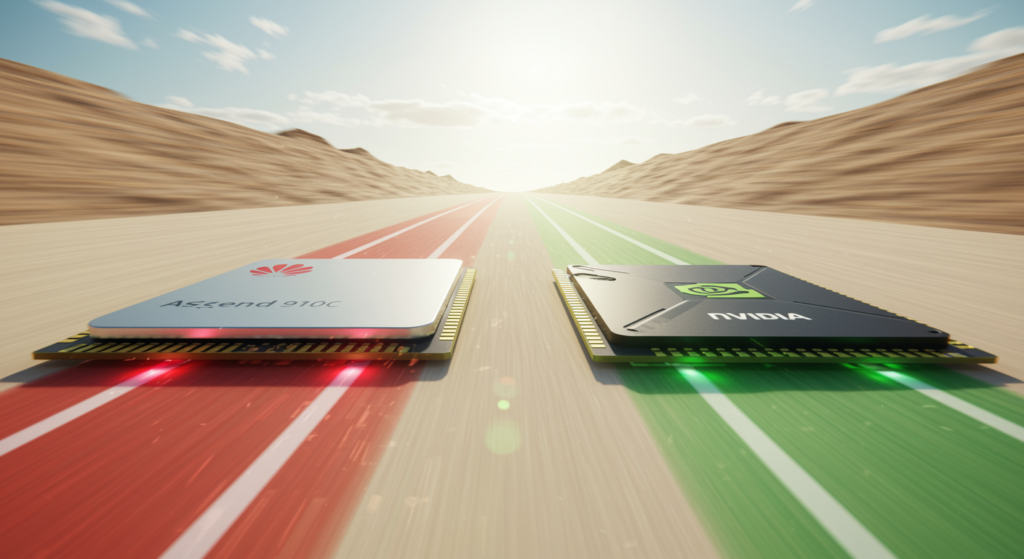
Huawei AI Chip Challenges Nvidia’s H100 Dominance
Huawei AI Chips: Emerging as a Formidable Force
Huawei AI Chips are making waves in the tech world, directly challenging Nvidia’s stronghold with the H100 series. This competition highlights China’s rapid advancements in semiconductor technology, especially amid U.S. export restrictions that have pushed Huawei to innovate independently. As you dive into this, consider how these developments could shift the balance of power in AI processing.
The launch of Huawei’s Ascend series, including the powerful Ascend 910C, positions Huawei AI Chips as a viable alternative for high-performance computing. In a market where efficiency and speed are paramount, Huawei’s efforts underscore a broader push for technological self-reliance, potentially reshaping how businesses approach AI infrastructure.
Huawei’s Ascend Chips vs. Nvidia’s Offerings
Performance Comparison of Huawei AI Chips
When pitting Huawei AI Chips against Nvidia’s lineup, the results are intriguing. For instance, the Ascend 910B has shown about 80% efficiency compared to Nvidia’s A100 in training large language models, and in certain tasks, it even outperforms by up to 20% according to industry benchmarks. This isn’t just about numbers; it’s about real-world applications where cost and availability matter most.
Have you ever wondered what happens when supply chain disruptions limit access to top-tier hardware? For Chinese companies, Huawei AI Chips offer a local solution, reducing dependency on imports. While Nvidia’s H100 remains a benchmark for AI workloads, Huawei’s chips are closing the gap, making them a smart choice for enterprises looking to optimize without global delays.
Ascend 910C: Advancing the Huawei AI Chips Agenda
The Ascend 910C marks a bold step forward in the Huawei AI Chips evolution, though it doesn’t yet match Nvidia’s cutting-edge features. This chip emphasizes energy efficiency and processing power tailored for AI tasks, supported by China’s strategic investments in domestic tech. Imagine a scenario where data centers in restricted regions can still run complex AI models without external dependencies—that’s the potential here.
Despite challenges from sanctions, Huawei’s focus on refining Huawei AI Chips like the 910C could inspire similar innovations worldwide. It’s a reminder that competition often sparks progress, pushing the entire industry toward more accessible and sustainable solutions.
The AI Chip Market Landscape
Key Drivers Behind Huawei AI Chips Demand
The global AI chip market is booming, with Huawei AI Chips playing a growing role in this expansion. Valued at around $39.27 billion in 2024, it’s projected to soar to $501.97 billion by 2033, driven by the need for specialized hardware in AI applications. Factors like generative AI are fueling this growth, as these technologies demand chips that handle massive data processing efficiently.
Edge computing is another big driver, requiring AI chips to process data in real-time at the source. Governments and private sectors are pouring funds into R&D, creating opportunities for players like Huawei to capture market share. What if your business could leverage these chips for faster, more reliable AI deployments?
For example, in healthcare, Huawei AI Chips could enable quicker analysis of medical data, potentially speeding up diagnostics. This trend not only boosts efficiency but also opens doors for cost-effective innovations that benefit everyday users.
Competitive Landscape and Market Trends
Top AI Chip Makers and the Rise of Huawei AI Chips
In the competitive AI chip arena, Nvidia leads with its H100 and A100 GPUs, but Huawei AI Chips are gaining ground as a strong contender. Google with its Cloud TPUs and other firms are in the mix, yet Huawei’s Ascend series stands out for its focus on domestic markets. This diversity is healthy for the industry, fostering innovation and reducing monopolistic risks.
Think about how a multipolar market could lower costs for consumers—more options mean better prices and tailored solutions. Huawei’s entry is particularly timely, given geopolitical tensions that limit access to foreign tech.
Market Trends Shaping Huawei AI Chips
Current trends like the rise of edge AI are transforming devices from smartphones to smart homes, where Huawei AI Chips could excel in on-device processing. Enterprises are shifting to in-house AI setups for greater control and savings, while generative AI in data centers drives massive hardware investments. These shifts are creating a dynamic environment where adaptability is key.
Have you noticed how AI is becoming integral to daily life? From personalized recommendations to automated systems, the demand for efficient chips is only growing. Huawei’s strategic positioning could make it a go-to option for regions prioritizing local tech ecosystems.
Future Outlook for Huawei AI Chips and the Market
Challenges and Opportunities for Huawei AI Chips
Looking ahead, Huawei AI Chips have a promising yet challenging path, with opportunities in edge computing and generative AI potentially offsetting the need to match Nvidia’s pace. Huawei’s investments in R&D could lead to breakthroughs that enhance global AI accessibility. However, keeping up with rapid technological advancements remains a hurdle, especially under regulatory pressures.
Opportunities abound in expanding markets, like integrating AI into IoT devices or sustainable tech. A hypothetical scenario: What if Huawei’s chips powered a network of smart cities, improving energy efficiency and urban planning? This could not only boost Huawei’s profile but also contribute to worldwide tech progress.
In summary, the evolution of Huawei AI Chips is poised to influence the AI chip market profoundly. As Nvidia holds its ground, Huawei’s rise signals a more competitive, innovative future shaped by global dynamics.
References
For more insights, this analysis draws from various sources. A study from TipRanks highlights Huawei’s AI surge (TipRanks). Performance comparisons are based on SemiWiki discussions (SemiWiki). Market projections come from Deloitte’s outlook (Deloitte) and Astute Analytica (GlobeNewswire). Additional trends are sourced from TechInsights (TechInsights), SEO.ai (SEO.ai), and other reports like those from IConnect007 (IConnect007) and a YouTube analysis (YouTube).
What’s your take on this AI chip rivalry? Share your thoughts in the comments, explore more on our site, or check out related articles to stay ahead in the tech game.
Huawei AI Chips, Nvidia H100, AI Chip Market, Ascend 910C, Semiconductor Industry, AI Processing, Tech Competition, China Tech, AI Hardware, Generative AI




